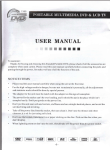Download VirtualPT V2 Clinician Student Manual
Transcript
Virtual PT Clinician Instr uc to r Manual S tudent Manual √ Contents Copyright.............................................................................................................2 Getting Started..................................................................................................3 Accessing a VirtualPT Patient Case............................................................................................3 Working Through the Case...............................................................................4 The Patient’s Presenting Situation...............................................................................................4 Common Buttons...........................................................................................................................5 Entering Problems & Hypotheses..................................................................................................6 Interview & Exam Sections.................................................................................................................7 Dx Tests........................................................................................................................................8 Diagnosis and Prognosis...........................................................................................................9 Goals & Management....................................................................................................................10 Initial Self-Assessment..............................................................................................................11 Browser and Technical Requirements........................................................12 w w w. v p t c l i n i c i a n . c o m 1 Copyright © 2014 DxR Development Group, Inc.,1840 Innovation Drive, Carbondale, Illinois 62903-9919, for software template and icons. All rights reserved. No part of this software program, including artwork and text, may be utilized, reproduced, stored, or transmitted in any form by any means, electronic or mechanical, or by any information storage or retrieval system, without permission in writing from the copyright holder. Address inquiries to DxR Development Group, Inc., 1840 Innovation Drive, Carbondale, Illinois 62903-9919. Licensee of the software has permission to duplicate the printed manuals, and to print and duplicate manuals downloaded from the DxR Development Group website. Macintosh and Safari are registered marks of Apple Inc. Windows and Internet Explorer are registered marks of Microsoft Corporation. QuickTime is a trademark of Apple, Inc. DxR Development Group, Inc., is a licensed distributor of QuickTime. QuickTime and the QuickTime logo are trademarks used under license. Firefox is a registered trademark of the Mozilla Foundation. Google and the Google Chrome are registered trademarks of Google Inc. Portable Document Format (PDF) and Acrobat are trademarks of Adobe, Inc. Brands and product references noted are the trademarks of their respective companies 2 Te c h S u p p o r t 8 0 0 4 5 3 - 8 0 4 0 Getting Started Accessing a VirtualPT Patient Case 1. Make sure you have the Web site location and the name of the case you have been assigned to work on. Navigate to that location in your browser. 2. Find the case on the Web site address provided by your instructor or in VirtualPT’s waiting room. Click on the case file [See Figure 1]. 3. Enter your assigned name and password in the spaces provided. Click Enter. If there has been a log-in error, a warning message will appear. Check to make sure your assigned name and password are entered exactly as your instructor requires. Once your assigned name and password are properly entered, click Start. (If this isn’t the first time you’ve accessed this case, follow the steps above and click Continue Case.) Figure 1. Case files in a Waiting Room As you enter a VirtualPT Clinician case, keep in mind, instructors and case authors can design cases and criteria as they wish. The following instructions take into account all case options available to the instructor.Your instructor may have chosen some or all of those options for this case. w w w. v p t c l i n i c i a n . c o m 3 Working Through the Case The Patient’s Presenting Situation This window introduces you to the patient and the patient’s stated reason for seeking help from a physical therapist [See Figure 2]. Read the information carefully, then click one of the three buttons under “What would you like to do next?” Your choices are: the Interview button for asking the patient questions; the Exam button for conducting a physical exam; or the Dx Tests button for ordering diagnostic tests. If there is a patient referral it will appear on this screen.You can access these sections in any order you like. Figure 2. Presenting Situation 4 Te c h S u p p o r t 8 0 0 4 5 3 - 8 0 4 0 Common Buttons Before you start your clinical investigation, review the buttons common to all screens within a VirtualPT Clinician case as well as the exam buttons shown on the right of this page. These buttons (Interview, Exam, Diagnostic Tests, and Problem/Hypothesis List) appear at the top of most screens and allow you to access the major portions of the VirtualPT case. Click one of those buttons to go to the corresponding section of the case. The Management (Rx) button allows you to enter a management plan for the patient.You should have completed the patient investigation and be ready to enter a diagnosis, a prognosis, goals, and interventions for the patient when you click the Management (Rx) button. Click the Notes button to see or add notes to help you as you proceed through a case.You may also review any of the investigation items you’ve selected so far.You can add to your notes by typing in text or by copying and pasting text into the Notes field. Click Save to preserve your entry. Click View Printable and your Notes are available in a printable form. The Learning button allows you to make note of any learning issues you would like to further study or investigate after completing a VirtualPT case. Categories include Anatomy, Behavioral and Social Science, Biochemistry, Clinical Medicine, Microbiology, Pharmacology, and Physiology. Type your entries into the appropriate text box and click SAVE. The SOAP button allows you to enter notes for Subjective Data, Objective Data, Assessment Data, and Plan. Type the text in the appropriate box and click SAVE. When the Web Links button is displayed, Web-based resources are available to assist you as you work through the patient case. SELECT BODY VIEW: Head Chest Abdomen Body (full) Physical Exam Buttons Vital Signs Flashlight/Ophthalmoscope/ View Accessory Motion/ Strength /Thermometer Palpate/ ROM / Stopwatch Percussion/ Stethoscope/ Sphygmomanometer Pin/ Hammer/ Cotton/ Tuning Fork Functional Mobility Mental Status Tests & Measures Click Web Links, then click the link text which opens a new browser tab or window displaying the additional information. w w w. v p t c l i n i c i a n . c o m 5 Problems & Hypotheses Entering Problems and Hypotheses You may be asked to supply a list of patient problems with associated hypotheses before you are allowed to proceed in your investigation. If you are not ready to supply a list of Problems and Hypotheses you will be advised to go to the Interview section (use the Interview button). In the Interview section you may ask the patient questions ONLY from the Present Illness category prior to developing your problem/hypothesis list. Once you have asked enough questions in the Present Illness category to enter at least one problem with an associated hypothesis, click the red Click Here link text or click the Problem/Hyp List button. If you believe you can provide an initial list of Problems and Hypotheses: 1. Enter the reported patient problems in the text box marked “Concise statement of the patient’s major problem.” 2. Enter a patient problem in the text box 'add problem' and click 'add problem'. Continue adding all your problems that you see at this time.You may prioritize your problems by using the up and down arrows on the right side of the problem/hypothesis box. Select a problem and click DELETE if you want to remove an item from your list. Next you must enter at least one hypothesis to associate with any patient problems you have entered. Follow these steps: 1. Enter your hypothesis in the text box 'add hypothesis'. 2. Check the box in front of any problem with which you wish to associate your new hypothesis. 3. Once you have associated your hypothesis with all problems that you think appropriate, click 'add hypothesis'. To delete a hypothesis, check the box in front of that hypothesis and click 'delete'. Click ‘done’ when you are finished entering your list of patient problems with associated hypotheses. The Problem/Hypothesis List screen may appear after each section of the VirtualPT case.You may also access this screen from any section of the case by clicking the Problem/Hypothesis List button. 6 Note: If you delete a problem that has unique hypotheses associated with it, those hypotheses will also be deleted. However, if you delete a problem that has associated hypotheses that are also associated with other problems, those hypotheses will remain in your list. Figure 3. Entering Problems Te c h S u p p o r t 8 0 0 4 5 3 - 8 0 4 0 IChapter n t e r v i eHeader w & Exam Sections Interview Section Questions in the Interview section are divided into 17 different categories listed on the left side of your screen. Depending on your instructor’s choice, you may not be able to access questions in categories other than the HPI Summary or the Present Illness until after you’ve entered or reviewed your Problem/Hypothesis List. To pose a question, select the interview category. A list of questions within that category appears. Select your question and the hypothesis you are investigation (see note). Click 'Ask' or double-click the question to see the patient's response to your inquiry. Repeat this process for each interview question you would like to pose. When you are done with the Interview section, click the button corresponding to the portion of the case you would next like to access. Exam Section Most physical exams are defined by the body part being examined and the exam tool you use. [See Figure 4.] 1) Select the hypothesis you are investigating for each exam item, or select SCANNING if you aren’t investigating a particular hypothesis. 2) Click an exam tool to the right of the patient image. The top box 'Exam Tool' under the patient image displays the name of the exam tool you have chosen. 3) Click on any of the small four body view images, located above the exam tools, to display the part of the patient's body to be examined. When your patient image appears, move your cursor over the patient image. The body part will be displayed in the text box 'Body Part' under the patient image, then click the location to get patient results. 4) Review the results that appear in the window to the right of the patient picture. Some results may be text only, some may be graphics, and still others may be heart or breath sounds for you to listen to. Such sounds are best heard through headphones. 5) Specialized exams are found beneath the exam tools. Click functional mobility, mental status or tests and measures to access exams in these categories. Repeat the process described above for each exam you would like to conduct. When you are finished conducting exams, click the button corresponding to the section of the case you would like to access next. Associating Hypotheses You may be asked to select a hypothesis to associate with each item you select from the interview, exam, and diagnostic tests sections BEFORE you will be able to add that item to your investigation. If you are not investigating a particular hypothesis, select SCANNING from the hypothesis list at the top of the screen.To select multiple hypotheses to associate with your investigation selection, press the command (CTRL) key while clicking on the hypotheses you would like to associate. Efficiency Warning You will see a warning when you are within 3 of the total number of questions, exams, or diagnostic tests deemed acceptable to complete this case efficiently.You will be warned again when you are within 1 of that number.You may continue requesting items in that category beyond the limits, but if you do so, your clinical reasoning score will be affected. Figure 4. Exam screen w w w. v p t c l i n i c i a n . c o m 7 Dx Tests On the Diagnostic Tests screen you may order tests to further your clinical investigation of a patient case.You have three methods of ordering diagnostic tests. Each is described and pictured below.You will also be able to see the results of the tests you order.You may also be asked to justify your diagnostic test requests. Ordering with the Common Diagnostic Test buttons 1. Look for the diagnostic test you want to order in the list of 10 common tests [see Figure 5, upper] displayed on your screen. 2. (optional) To get information (a test description, normal values, and what Abnormal Indicates) on a Common Test before you order it, click Test Info and then click the name of the test. 3. To select a test in the Common Tests list, first select the hypothesis you are investigating, then click the test name you would like to order.Your patient's results will be displayed. Click the Normal button to compare your patient's results with normal results. Search If the diagnostic test you want to order isn’t in the Common Tests list and you don’t know which category it would be listed under, use the search function [see Figure 5, lower]. 1. Enter a key word or phrase in the space provided and click SEARCH (or Return/Enter). 2. Select the hypothesis you are investigating, then select your selected test in the window showing your search results. 3. Click TEST INFO (for a test description, normal values, and what Abnormal Indicates), or click ORDER to order the test immediately.Your patient's results will be displayed. Click the Normal button to compare your patient's results with normal results. Figure 5a. Common Lab Tests Categories & Lists If you know what category your diagnostic test is likely to be listed under, use the Categories option to find your test. 1. Select the category most likely to contain your test. 2. Find the specific test in the list that appears to the right of the category list. (optional) Click TEST INFO to see a test description, normal values, and what Abnormal Indicates. 3. Click the Order button to get your patient's results. Click the Normal button to compare your patient's results with normal results. Justifying Diagnostic Test Orders After ordering a diagnostic test, you may be asked to justify your request before you can see the test results. Type in your justification and then click Enter.You will then be allowed to access the results. Reviewing Diagnostic Test Results Some results will consist only of text but other tests results may include graphics. Make a note of anything you think is important to the case. Click the Normal button to compare your patient's results to normal results. 8 Te c h S u p p o r t 8 0 0 4 5 3 - 8 0 4 0 Figure 5. Proposed Dx Test Orders Diagnosis and Prognosis Diagnosis and Manage the Patient Problems Click the Rx (Management) button when you are ready to diagnose and manage the patient problems. You will follow a linear path to develop the appropriate management plan for your patient. Figure 6. Diagnosis entry Step 1. Prioritize the Problem List You will be given a final opportunity to review your problem list and prioritize the problems in your list. To prioritize your problem list, select an item in the list and click either the UP or DOWN button to move that item in the list. Click Continue when you are satisfied with the priority order of your Problem List. Step 2. Diagnosis Please note, once you enter your final diagnosis, you will no longer be able to access the patient history, exam, or diagnostic tests sections. If you are not ready to enter your final diagnosis, click Cancel to return to the patient investigation sections of the case. 1. Enter your diagnosis in the text box at the top of the screen. 2. Justify your diagnosis in the second text box by typing in findings from your investigation that support this diagnosis. 3. Select your level of confidence in your diagnosis. Click Cancel to cancel your entries and close the Diagnosis screen. Click Enter Final Diagnosis to save and enter your final diagnosis. Figure 7. Problem List review Step 3. Review Problem List After your final diagnosis is entered, you will have the opportunity to review your problem list and compare it to the problem list expected by your instructor. Review the instructor list carefully. As you proceed to Management, all of your management plan selections should be based on the Instructor’s problem list alone. Step 4. Mode of Treatment Select the mode of treatment that you think is appropriate for this patient. Your choices are: Treat Patient, Treat Patient and Refer, or Refer Prior to Treatment. If you choose to ‘refer’ a patient, you must select the type of specialist to whom you would refer the patient. Click Continue when you are satisfied with your mode of treatment. Step 5. Prognosis Depending on your instructor’s choices, you will enter your prognosis for this patient in one of two ways; either by typing your prognosis in a text box in narrative form, or by answering two multiple-choice questions. 1. Review the instructor's problem list at the top the screen before you enter your prognosis. 2. If your instructor has chosen to have you select your prognosis by answering two multiple choice questions, select the best option for each question and click Continue. 3. If your instructor has chosen to have you enter your prognosis as a free text entry, enter your prognosis in the 'Enter expected prognosis' box. When you are finished, click Continue. w w w. v p t c l i n i c i a n . c o m Figure 8. Prognosis 9 GChapter o a l s & Header Management Step 5. Goals On the Goals screen, you will be required to type in goals for each patient problem identified by the instructor. 1. Select a patient problem in the Instructor’s Problem List. 2. Type in your goals for the selected problem and click Save.You may also link a previously entered goal to additional problems. At the bottom of the screen click the arrow next to 'Link this goal to another problem' to display a drop down menu containing the Instructor's expected problems. After you have selected the problem to link your existing goal to, click Save. 3. Repeat this process for each problem in the Instructor Problem List. 4. Click Continue when you’ve entered goals for each problem in the Instructor Problem List. Figure 9. Entering Goals Step 6. Patient Management In this section, you will develop a management plan designed to meet your identified goals for the patient. 1. Select one of the Management categories that appear (Interventions, Collaboration, Education, Counseling). Select the patient problem you are managing. (If you select the Interventions category, you may need to select from several sub-categories that will appear). 2. Repeat this process until you have selected all the management choices you think are necessary for this patient.You are not required to select management for each problem in the Instructor Problem List. When your management plan is complete, click Evaluate. Step 7. Frequency and Duration You will be asked to recommend the frequency and duration of treatment for your patient. 1. Under Frequency, click one of the five possible selections to best manage your patient. 2. Under Duration, click one of the three possible selections to best manage your patient. Click Done when completed. Step 8. Management Confidence When you click Evaluate on the Patient Management screen, the Management Confidence window appears. Answer the four questions posed to indicate your level of confidence in your management plan selections. Click Done when you’ve completed all questions. Congratulations! If your instructor has turned on the Initial Self-Assessment feature, you may now view your results. Follow the steps under Initial Self-Assessment. 10 Te c h S u p p o r t 8 0 0 4 5 3 - 8 0 4 0 Figure 10. Patient Management Initial Self-Assessment Initial Self-Assessment Following the Management Confidence screen, the program will perform an initial evaluation of your entries. Depending on your instructor’s preferences, you may be able to review the initial assessment of your work. Click Review Results to access the Self-Assessment. Diagnosis Self-Assessment - The diagnosis screen allows you to compare your diagnosis with the expected diagnosis listed by the instructor. You will be able to assess how you think your diagnosis compares to that of the instructor by selecting either Mostly, Somewhat, A Little, or Not at All. The instructor will be able to review your self-assessment as he/she evaluates your performance in the case study. Problem/Hypothesis List Self-Assessment - This screen allows you to compare your list of problems and associated hypotheses with the standards set by the instructor. You will be able to assess how your list compares with the instructor by selecting either Mostly, Somewhat, A little, or Not at All. The instructor will be able to review your self-assessment as he/she evaluates your performance in the case study. Investigations Assessment - The Critical Investigations screen allows you to see whether or not you selected the appropriate investigative items for this virtual patient encounter. A star will appear next to the name of each item that you selected that is correct. To see the information that you missed in your investigation, click the items with no star. The table at top of the screen allows you to see the number of required items as compared to the number of items you selected. Prognosis Assessment - The prognosis screen displays the responses to the two multiple choice questions.Your instructor's selections are shown and your selections will either have a star in front of it if you matched the instructor's selection or an X if you did not. If your prognosis was a free text entry, no initial assessment was made.Your instructor has the opportunity to assess your entry as he/she evaluates your performance in the case study. Interventions Assessment - The Interventions screen allows you to review your selected interventions and see an assessment of whether your selections were appropriate for your virtual patient. If your interventions were correct, a star will appear next to the item name. w w w. v p t c l i n i c i a n . c o m 11 Browser and Technical Requirements Browser Requirements Cookies and Javascript must be enabled. Your browser must also have the latest version of the Apple QuickTime™ player plug-in installed. Make sure you select a full install of QuickTime. We support these standard Web browsers: • Microsoft® Internet Explorer • Google Chrome™ • Firefox® • Safari® Screen Size and Monitor Resolution VirtualPT Clinician requires a minimum monitor resolution of 1024 x 768 pixels. If your monitor is not set for 1024 x 768 pixels or higher resolution, portions of your screen may be cut off and a warning message may appear when you try to log in to the case. Your monitor must also be set display at least 16 bit color (thousands of colors). If your monitor is not set to display 16 bit or higher color, images and movies may appear distorted, pixilated, or washed out on your screen. Sound Your computer must have a sound card installed. Heart and breath sounds will sound best when heard through headphones. Re-enabling QuickTime to play MP3s on Windows If QuickTime™ is not enabled to play MP3s on your Windows® machine, the following directions will help you restore the settings to properly play sounds in the case studies. 1. Locate the Start Menu icon in the menu bar across the bottom of your screen. 2. Click the Control Panel to open it. 3. Locate the QuickTime control panel and click to open it. 4. At the top of the QuickTime window, select the Browser tab. 5. Click the MIME Settings button at the bottom of the window. 6. Scroll to locate the item ‘MP3’ in the list. Click to expand that item, displaying two selections: MP3 Audio and MP3 Playlist. Both should have a checkmark beside them, meaning they are activated. If both ‘MP3’ items don’t have a checkmark associated with them , click the checkbox. Once the checkmark appears preceding each item, they are enabled. 7. QuickTime has now been re-enabled to play MP3s. Click OK to close the window. 12 Te c h S u p p o r t 8 0 0 4 5 3 - 8 0 4 0 DxR Development Group, Inc. For More Information, please Call Toll-Free 866-599-1140 or Visit us on the Web www.dxrgroup.com


























